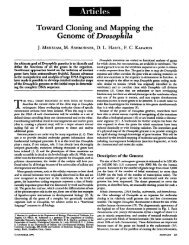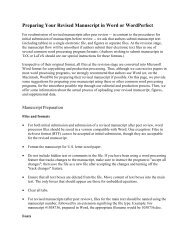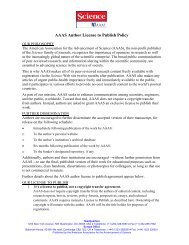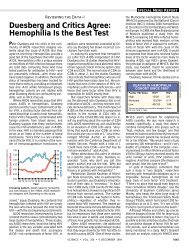Chinese Academy of Sciences (PDF) - low res version
Chinese Academy of Sciences (PDF) - low res version
Chinese Academy of Sciences (PDF) - low res version
Create successful ePaper yourself
Turn your PDF publications into a flip-book with our unique Google optimized e-Paper software.
CREDIT: COURTESY OF CAS<br />
Research CAS/In Focus<br />
Figure 3. Ecological rehabilitation <strong>of</strong> hydr<strong>of</strong>luctuation<br />
belt <strong>of</strong> Three Gorges Reservoir Area.<br />
Ecology and Regional Agriculture<br />
In this field, <strong>res</strong>earch has mainly focused on soil science and ecosystem<br />
processes based on field monitoring networks, ecological <strong>res</strong>toration, agricultural<br />
geography and regionalization, and regional agricultural technical<br />
trials and transfer.<br />
Example: Ecological Restoration and Demonstration<br />
Significant prog<strong>res</strong>s has been made in ecological <strong>res</strong>toration based on<br />
data from eight ecological <strong>res</strong>toration experimental regions that have<br />
been set up in fragile and at-risk areas <strong>of</strong> West China (Figure 2). Advances<br />
have been seen in understanding the mechanisms <strong>of</strong> <strong>res</strong>toration for<br />
degraded ecological systems, ecological system <strong>res</strong>toration modeling,<br />
comprehensive management and regulation <strong>of</strong> river basins, highly efficient<br />
development and exploration <strong>of</strong> water <strong>res</strong>ources, and regional economic<br />
development modeling. Related technologies and models have<br />
been applied extensively in the region. The models developed provide<br />
a basis for carrying out more eco-friendly construction and economic<br />
development in West China (Figure 3).<br />
Environmental Science and Technology<br />
Research fields in this area include the study <strong>of</strong> persistent organic pollutants<br />
(POPs), environmental impact studies and regional environmental<br />
quality assessments, as well as the development <strong>of</strong> water pollution control<br />
technologies and demonstration projects, soil pollution control technologies<br />
and demonstration projects, air pollution monitoring and control technologies,<br />
and cleaner production technologies and demonstration projects.<br />
Example: Study on Persistent Organic Pollutants<br />
The <strong>res</strong>ults from studies on POPs have aroused wide<br />
concerns. Innovative methods for the analysis <strong>of</strong> dioxins,<br />
polychlorinated biphenyls, and other POPs have recently<br />
been developed and validated, enabling the development<br />
<strong>of</strong> state-<strong>of</strong>-the-art techniques for POPs monitoring<br />
in China. Dioxin formation during the production <strong>of</strong> pdichlorobenzene<br />
has been clarified for the first time. New<br />
mechanisms <strong>of</strong> action <strong>of</strong> the toxin pentachlorophenol and<br />
its metabolite, tetrachloro-1,4-benzoquinone (also called<br />
p-chloranil), have been revealed through the discovery <strong>of</strong><br />
a new pathway for the formation <strong>of</strong> the extremely reactive<br />
hydroxyl radical and a novel carbon-centered quinone<br />
ketoxy radical. The emission factor for dioxins during production<br />
<strong>of</strong> p-dichlorobenzene has been determined and<br />
has been adopted and recommended by the United Nations<br />
Environment Program to estimate dioxin emissions<br />
worldwide. In addition, the emission inventory <strong>of</strong> dioxins<br />
in China has been established, which provides a scientific<br />
basis to implement the Stockholm Convention on POPs<br />
in China.<br />
Global Climate Change<br />
China was one <strong>of</strong> the first countries to actively promote establishment<br />
<strong>of</strong> the International Geosphere-Biosphere Program<br />
and several other international <strong>res</strong>earch programs on<br />
global climate change. Since the mid 1980s, global climate<br />
change <strong>res</strong>earch has been considered a priority by most <strong>of</strong><br />
the national funding agencies and has led to fruitful scientific<br />
<strong>res</strong>ults, including key data and theories on the causes<br />
<strong>of</strong> global environmental change.<br />
Example: Study on Global Climate Change<br />
CAS scientists have made important contributions in this area. Data on<br />
ter<strong>res</strong>trial long-term climate changes that is on a par with marine and<br />
ice-core records has been collected. Scientists have documented a complete<br />
and continuous climate history <strong>of</strong> the Asian continent on both the<br />
tectonic and orbital timescales. Various climate data, in particular historical<br />
records and a reliable climate time line (at a <strong>res</strong>olution <strong>of</strong> years to<br />
decades), show that the 20th century may not in fact be the warmest in<br />
the past 2,000 years. Studies <strong>of</strong> the lacustrine records from Heqing have<br />
extended the history <strong>of</strong> the Indian summer monsoon back to 2.6 million<br />
years ago, providing a new understanding <strong>of</strong> glacial-interglacial Indian<br />
monsoon dynamics.<br />
Outlook<br />
Looking to the future, the <strong>res</strong>earch focus will be in the fol<strong>low</strong>ing areas:<br />
deep processes and lithosphere evolution; interactions among multisphe<strong>res</strong><br />
on the Qinghai-Tibetan Plateau; models <strong>of</strong> climate systems,<br />
earth systems, and land surface process integration systems; the origin<br />
<strong>of</strong> life and evolution; and the ocean environment and ecosystems. At the<br />
same time, to meet the strategic requirements for state economic and<br />
sustainable development, special emphasis will be placed on the <strong>res</strong>toration<br />
<strong>of</strong> damaged ecosystems and <strong>res</strong>toration trials, key metallogenic<br />
theories and exploration technologies, key oil and gas exploration theories<br />
and technologies, comprehensive estimations for water <strong>res</strong>ources<br />
and their efficient utilization, and <strong>of</strong>fshore biological <strong>res</strong>ources and marine<br />
biotechnology.<br />
19
















